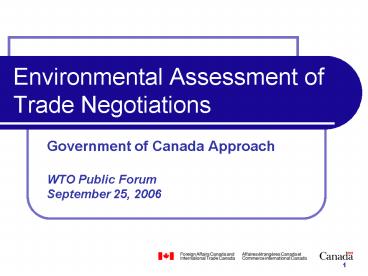Environmental Assessment of Trade Negotiations - PowerPoint PPT Presentation
Title:
Environmental Assessment of Trade Negotiations
Description:
Why assess environmental impacts of trade negotiations? ... all guidance and reports: http://www.dfait-maeci.gc.ca/tna-nac/env/env-ea-en.asp ... – PowerPoint PPT presentation
Number of Views:44
Avg rating:3.0/5.0
Title: Environmental Assessment of Trade Negotiations
1
Environmental Assessment of Trade Negotiations
- Government of Canada Approach
- WTO Public Forum
- September 25, 2006
2
Overview
- Why we do environmental assessment (EA) of trade
negotiations - Canadas approach
- Context
- Key objectives and activities
- Experience
- Recent progress and challenges
3
Why assess environmental impacts of trade
negotiations?
- Gain understanding of trade-related environmental
impacts - Enhance positive impacts
- Mitigate negative impacts
- Inform policy makers and trade negotiators
- Facilitate integrated decision making
- Promote mutual supportiveness of trade and
environmental objectives
4
EA of Trade Negotiationsin Canada
5
Context
- Canadian Cabinet Directive on the Environmental
Assessment of Policy, Plan and Program Proposals - 2001 Framework for Conducting Environmental
Assessments of Trade Negotiations - Complemented by Handbook
- Interdepartmental approach
- Previous Canadian and international efforts
6
EA Framework Key Elements
- Objectives inform negotiators and address public
concerns - Scope issues for which we have a negotiating
mandate - Focus domestic environmental effects
- Process three phases of increasingly detailed
analysis based on progress in negotiations - Methodology environmental analysis flows from
economic analysis - Consultations throughout
7
Potential phases of a Full EA
8
4-Step Analytical Methodology
- Identification of the economic effects of the
negotiations - Identification of the likely environmental
impacts of such changes - Assessment of the significance of the identified
likely environmental impacts - Identification of enhancement/mitigation options
9
Types of trade-related effects
- Effects can be positive and negative
- Five types of trade-related effects
- Scale
- Structural
- Product
- Technology
- Regulatory
10
As negotiations proceed
Mandate and agreement to negotiate
- Initial understanding of topics to be negotiated
- e.g., tariff-related issues (agriculture, NAMA),
services, rules and trade facilitation
Increased understanding of general outcome
Negotiation of specifics
Signed Agreement
11
Roles and responsibilities
- Interdepartmental EA Committee for each
negotiation - Chaired by the Chief negotiator
- Analysis is undertaken by trade negotiators in
consultation with experts in key departments and
agencies (including Environment Canada and the
Canadian Environmental Assessment Agency) - Communications and consultations expert
- Interdepartmental Steering Committee oversees EA
work and provides guidance - Choose areas to focus efforts for improvement
every year
12
Consultations
- Strong commitment to consultations throughout
- Consult with
- Interdepartmental community
- Provinces and Territories
- EA Advisory Group (academic, industry, NGO
representatives) - Canadian public
- report issued at end of each phase of the EA
13
Canadas Experience
14
EAs undertaken
- Completed
- Initial EA for WTO, FTAA, CA4, and Singapore
trade negotiations - Initial EA for Canada-Peru Foreign Investment
Promotion Agreement (FIPA) - Underway
- Initial EAs for bilateral trade negotiations with
the EU and Korea, FIPAs with India and China - Draft EA for WTO Doha Development Agenda
- Final EA for Canada-Peru Foreign Investment
Promotion Agreement (FIPA)
15
Overview of WTO EA process
- Initial EA of the Doha Negotiations
- Notice of Intent issued indicating EA would be
completed and requesting comments - Report released November 2002 with request for
public comments - Draft EA currently in progress
- Interdepartmental committee established under
chairmanship of chief negotiator - Scope of analysis based on findings from Initial
EA, comments received from Initial EA, as well
as areas where there is a new negotiating mandate
(e.g. trade facilitation) - Analysis and drafting conducted by Government of
Canada trade negotiators and environmental
experts - Provinces and territories consulted on
preliminary Draft EA report - EA Advisory Group consulted on preliminary Draft
EA report - Feedback circulated to WTO EA Committee and EA
Steering Committee to inform further work
16
Progress and challenges
17
Analysis
- Progress
- Some progress on quantitative analysis, but
remains largely qualitative - Use of indicators to provide info on key
relationships and issues - Application of the EA Framework to foreign
investment protection agreements (FIPAs) - Challenges
- Limits of quantitative modelling
- Lack of comprehensive environmental data
- No one stop shop for information
- Difficulty assessing effects attributable to the
negotiation
18
Communications and consultations
- Interdepartmental committee
- Positive working relationship
- Improved awareness
- Constructive
- Commitment to ongoing improvement
- Limited feedback from public
- Recent efforts
- Improve documentation
- Established expert advisory group
- Outreach
19
Ongoing challenges and efforts
- Data limitations
- Consultation outcomes
- Timing
- Areas of negotiations that are not tariff-related
- Follow- up
20
In summary.
- Steep learning curve incremental improvements
- Positive outcomes from internal approach to
analysis - Committed to continuing to share information
- Visit our web-site to see all guidance and
reports http//www.dfait-maeci.gc.ca/tna-nac/env/
env-ea-en.asp































